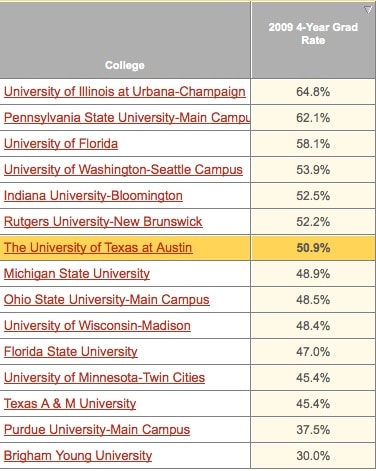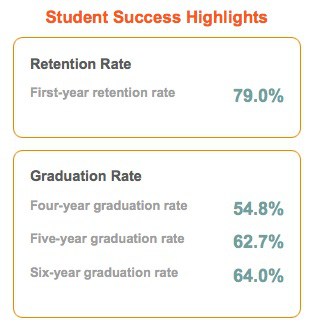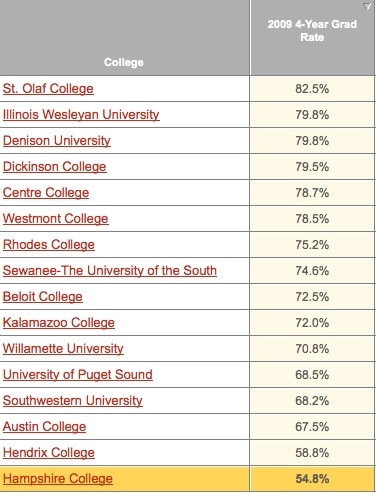I met a teenage girl during the fall who was excited about applying to Hampshire College.
She had visited the campus in Amherst, MA, had met professors and talked with students. She was smitten. She and her mother felt good that they had done their due diligence on the college, but then I asked them a question that drew a blank stare: Do you know what Hampshire’s four-year graduation rate is?
Overlooking Graduation Rates
They didn’t know what it was and that’s strangely common. Every year students apply to schools without ever knowing if they have a good shot of graduating in four years. Most college students, by the way, don’t graduate in what used to be the traditional eight semesters.
When I give talks out here in California and share a Power Point slide with four-year grad rates of some of the state universities, it always triggers a collective gasp from the audience. Really!
Examples:
- San Francisco State: 11.7%
- San Jose State 7.7%
- San Diego State 28.5%, which in the Cal State system is a stellar performance!
Now you might assume that students who attend a liberal arts college that costs $54,000 are going to graduate on time, but that’s a dangerous assumption. I happened to know that Hampshire’s graduation rate is strangely low for an expensive, selective school. The school’s four-year grad rate is 54.8%.
I got that figure from College Result Online, which is my favorite source for graduation rates. At College Results Online, which is brought to you by the Education Trust, you can obtain a college’s four, five and six-year rates. Here are Hampshire’s grad statistics:
Comparing Peer Institutions
One of the features that I particularly like about College Results Online is that the site will generate the names of peer institutions for you so you’ll get a sense about whether a school’s grad rate is good or not for the company it keeps. Feeling good about Hampshire’s grad rate compared to San Jose State won’t cut it because they are entirely different institutions.
The cool part about the site’s software is that you don’t have to know what a school’s comparable institutions are. Simply hit the Similar Colleges button. When I did that in Hampshire’s case, the software generated this list of peer institutions with their four-year grad rates.
You can see that Hampshire lands at the very bottom. While Hampshire’s 54.8% four-year grad rates is alarming, it looks even worse when compared to some of its peers.
How Grad Rates Are Calculated
You should know that grad rates are a bit misleading for all schools simply because of the way that the federal government collects them. These figures only reflect the graduation rates of students who began as full-time freshmen and graduated four years later. Strangely, the federal government never tracks what happens to part-time students.
Equally odd, full-time students who end up transferring to a different college are counted as non-graduates of their original college. So obviously schools where many students leave will have lower grad rates than others. That’s clearly an issue at Hampshire, which leads to another disquieting statistic. Hampshire’s freshmen retention is low for a highly selective private school. The freshman retention rate is only 79%. What’s with that?
When you are paying top dollar for a private college, the fact that 21% of students leave after freshman year is something to worry about.
State School Example
Now let’s look at a state university. I picked the University of Texas at Austin simply because Texas is the third biggest draw for my blog after California and New York state. In general, state flagship universities have higher grad rates than the vast majority of other public universities.
A student’s chance of graduating on time at the University of Texas, which draws a far more diverse student body, is about as good as getting “tails” on a single coin toss. (Twenty three percent of students at UT are low income versus 12% at Hampshire.) Most Texas students require five years to graduate. When I see a grad rate like this, I’d want to know who is graduating in four years to assess my own child’s chances of being in that group. Far more students return for a second year at Texas.
Now let’s look at some of the Texas flagship’s peers:

Bottom Line:
When evaluating schools, always look at graduation rates. Even among schools of similar reputations, the grad rates can be dramatically different. Also find out what it would take at any particular school to graduate on time! Do so could ultimately save you tens of thousands of dollars.




Lynn: thanks for the tip about “College Results.” Amazing site! The ability to contrast and compare my high school junior daughter’s choices against similar colleges is quite enlightening and will allow us to focus our research. I only wish they’d include out-of-state tuition rates in their rankings (or am I overlooking it?), which would give us a much more accurate comparison among my daughter’s many (current) “dream” schools, all of which are out-of-state for us here in Alaska. Thanks.
Hi Denny,
Glad you like the tool. To get a sense of what you’d pay at out-of-state public universities, just use their net price calculators. A calculator will give you an estimated cost of what a particular school will cost. All school must post their calculators on their websites.
Lynn O’Shaughnessy
This is a very useful tool. In addition to 4-year graduation rates, I particularly like to see the % of full-time faculty at a school.
I do wish the site “default” was the 4-year rate, not the 6-year. Kind of telling about the state of higher education that this is not the case, don’t you think?
I totally agree with you. I think it’s puzzling that the grad rates you usually see published are six-year rates. I have yet to stumble across parents who hopes their kids take six years to graduate!
Lynn O’Shaughnessy
However, parents need to know that most college students do not graduate in 4years. A 6-year graduation rate has become the norm in this country.
Hi Deborah — A six-year grad rate is the norm, but I would never want to send my kids to a school where they couldn’t get out in four years.
Lynn O’Shaughnessy
As always Lynn, you’ve hit the nail on the head. Typically, any school that boasts a retention of freshmen to sophomore at an 80+% rate is considered as exceptional.
In addition to asking about 4 and 6 year graduation rates, it is helpful to drill down specifically into the academic discipline grad rate. Few schools offer this info without asking. Interestingly, few schools track this specific info.
Also, if a prospective student is a member of a “special” subset classification, i.e. minority, Pell Grant recipient, marching band member, lacrosse player, transfer student… ask about retention and graduation rates of those specific student “classifications”.
This is a good idea in theory, but in the wrong hands, it can be misleading.
The truth is that graduation rates mirror input rates; the more selective a college is, the more it is likely to have high graduation rates. And that’s not always a measure of things academic, either. Institutions with higher levels of selectivity tend to select wealthier students, thus removing one of the largest barriers to graduation.
US News and World report recently figured out that if you want to put these in context, you need to understand them against economic values, like the percentage of students on Pell grants. In the end, they have discovered that many institutions with seemingly lower graduation rates are actually doing a better job of graduating students than their wealthier peers. This is what they say:
The social mobility score is more complicated. We have data from the federal Integrated Postsecondary Education Data System survey that tell us the percentage of a school’s students on Pell Grants, which is a good measure of a school’s commitment to educating lower-income kids. We’d like to know how many of these Pell Grant recipients graduate, but schools aren’t required to track those figures. Still, because lower-income students at any school are less likely to graduate than wealthier ones, the percentage of Pell Grant recipients is a meaningful indicator in and of itself. If a campus has a large percentage of Pell Grant students—that is to say, if its student body is disproportionately poor—it will tend to diminish the school’s overall graduation rate.
Read the whole thing at http://www.washingtonmonthly.com/magazine/septemberoctober_2011/special_report/a_note_on_methodology_4year_co031631.php
The shocking truth is not always as shocking as it seems.
Hi Jon,
I agree that you have to compare apples with apples. You can’t compare San Francisco State with a Hampshire College. In the post, Hampshire College was compared with its own peers.
I like College Results Online because you can easily see how many Pell Grant students attend a school. Twenty two percent of UT undergrads, as I mentioned, are Pell Grant recipients. Only 12% of Hampshire students fall into that category. I also appreciate the fact that on College Results Online you can see what the grad rates are for different minority groups, which is important. Some universities that cater to low-income students do a great job of graduating everybody and some do a miserable job.
Lynn O’Shaughnessy